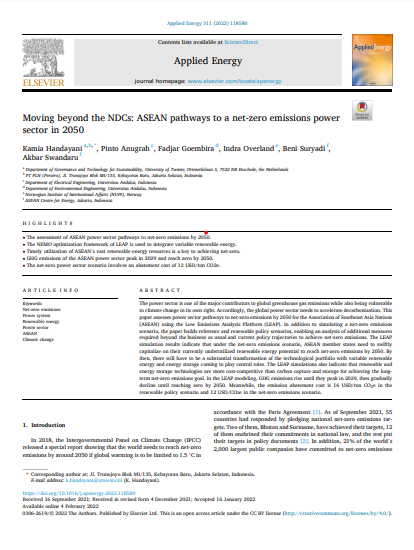
Keyword(s)
Author(s)
Kamia Handayani, Pinto Anugrah, Fadjar Goembira, Indra Overland, Beni Suryadi, Akbar Swandaru
Publisher
Published Date
Access
DOI
c) Department of Electrical Engineering, Universitas Andalas, Indonesia
d) Department of Environmental Engineering, Universitas Andalas, Indonesia
e) Norwegian Institute of International Affairs (NUPI), Norway
f) ASEAN Centre for Energy, Jakarta, Indonesia
The power sector is one of the major contributors to global greenhouse gas emissions while also being vulnerable to climate change in its own right. Accordingly, the global power sector needs to accelerate decarbonization. This paper assesses power sector pathways to net-zero emissions by 2050 for the Association of Southeast Asia Nations (ASEAN) using the Low Emissions Analysis Platform (LEAP). In addition to simulating a net-zero emissions scenario, the paper builds reference and renewable policy scenarios, enabling an analysis of additional measures required beyond the business as usual and current policy trajectories to achieve net-zero emissions. The LEAP simulation results indicate that under the net-zero emissions scenario, ASEAN member states need to swiftly capitalize on their currently underutilized renewable energy potential to reach net-zero emissions by 2050. By then, there will have to be a substantial transformation of the technological portfolio with variable renewable energy and energy storage coming to play central roles. The LEAP simulations also indicate that renewable and energy storage technologies are more cost-competitive than carbon capture and storage for achieving the long-term net-zero emissions goal. In the LEAP modeling, GHG emissions rise until they peak in 2029, then gradually decline until reaching zero by 2050. Meanwhile, the emission abatement cost is 16 USD/ton CO2e in the renewable policy scenario and 12 USD/CO2e in the net-zero emissions scenario.
Cite:
Kamia Handayani, Pinto Anugrah, Fadjar Goembira, Indra Overland, Beni Suryadi, Akbar Swandaru, Moving beyond the NDCs: ASEAN pathways to a net-zero emissions power sector in 2050, Applied Energy, Volume 311,
2022, 118580, ISSN 0306-2619, https://doi.org/10.1016/j.apenergy.2022.118580.